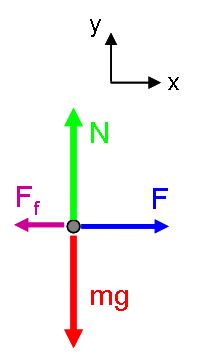
Part AA person pushes a box of mass 15 kg along a floor by applying a perfectly horizontal force F. The box accelerates horizontally at a rate of 2.0 m/s2.
Solution
The free body diagram for this situation is:
With this free body diagram, Newton's 2nd Law can be written:
where we have assumed that the y acceleration is zero because the box is sliding along a horizontal floor, not moving upward or downward. This realization is important, because we know Ff = μN. Thus, because the y acceleration is zero, we can solve Newton's 2nd Law in the y direction to yield:
so that:
|
Part BA person pushes a box of mass 15 kg along a floor by applying a perfectly horizontal force F. The box moves horizontally at a constant speed of 2.0 m/s in the direction of the person's applied force. Assuming the coefficient of kinetic friction between the box and the ground is 0.45, what is the magnitude of F?
|
